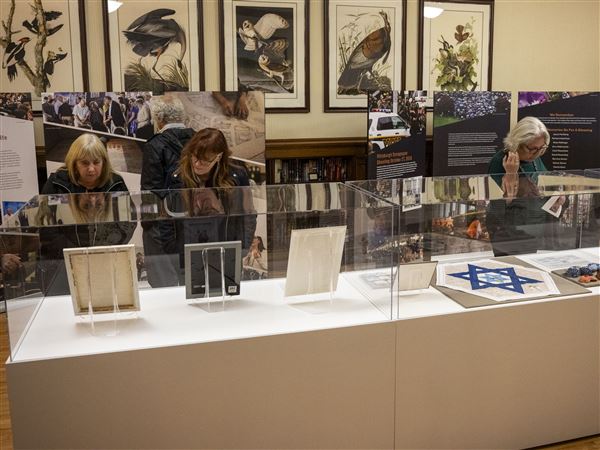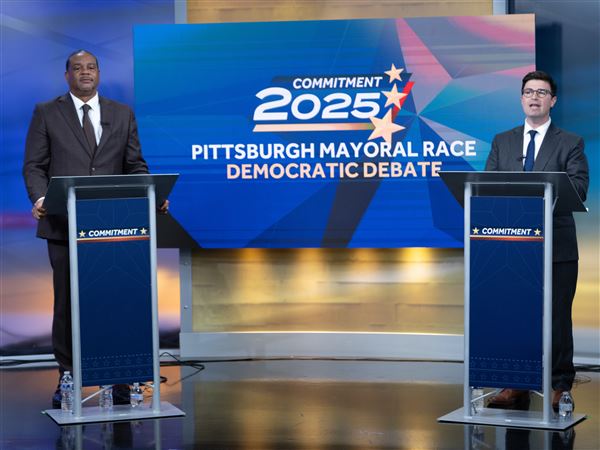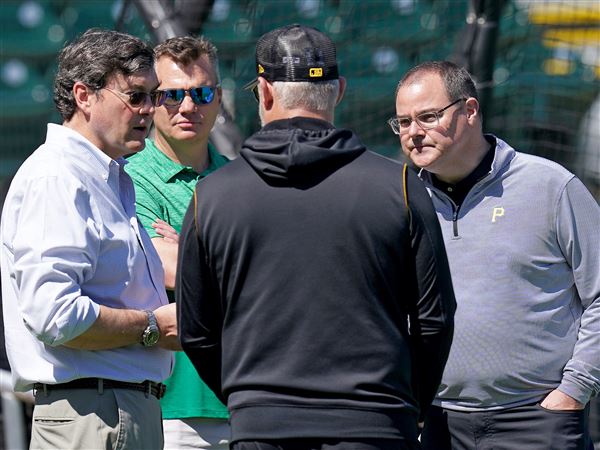The events of Nov. 22, 1963, refuse to stay inside the thousands of books written about them. Fifty years later, the killing of John F. Kennedy is relived and re-examined as though it happened yesterday. His alleged assassin, Lee Harvey Oswald, is still a mysterious figure in a strange world of communists, KGB enablers, Cuban exiles, mafia bosses, CIA plotters and duplicitous FBI agents.
Oswald never had the trial that might have provided answers. Instead, two days after JFK's death, he was slain in front of a live television audience of millions, gunned down by Jack Ruby, a strip-joint owner with a dog fetish and bona fide mob connections, as dozens of police officers stood slack-jawed.
Convicted of Oswald's slaying, Ruby died in prison in 1967 of fast-moving cancer after he asked to be taken to Washington, D.C., where he could talk freely. He was refused. The only reporter who had a private interview with him -- Dorothy Kilgallen -- died of a sleeping-pill overdose in 1965.
This carnival funhouse, anticipated by Orson Welles' distorted mirrors in "The Lady from Shanghai," goes on and on with no resolution in sight. You would think that time and modern technology would put the whole mess to rest and the pressing issues of the day could take precedence. But you would be wrong.
As someone who took the conspiracy bait almost from the day JFK died, and later found himself confronting some of the leading characters in this labyrinth of dead ends, fantastical claims and the familiar face of Cyril Wecht, I present my personal and historiographical account of America's stubborn obsession.
▪ ▪ ▪
The provocative historian Garry Wills wrote "The Kennedy Imprisonment" in 1982, a damning and ruthless meditation on the whole clan, from Joseph the father on down. The title struck me as a perfect description of the tireless obsession so many have had for the Kennedy assassination and the conspiracy theories that once snared me.
I'm free now, though I was tempted to attend last month's International Symposium on the 50th Anniversary of the Assassination of President John F. Kennedy, produced by the Cyril H. Wecht Institute of Forensic Science and Law at Duquesne University. It would have cost me $200 for the three days of conspiracy plots, autopsy photos and speculation presented by the usual suspects I know from writing about the assassination industry for so many years.
Dr. Wecht, the first independent expert to review JFK's autopsy files, discovered that the president's brain was missing. It now appears that what little was left was given to the victim's family. Dr. Wecht also is among the chorus of voices to question the "single-bullet theory" conjured by the late Arlen Specter, the Warren Commission lawyer who went on to serve three decades in the U.S. Senate for Pennsylvania.
Two early critics of Specter's argument -- Josiah Thompson and Mark Lane -- were on the symposium's program. So was conspiracy theorist Oliver Stone, whose 1991 film "JFK" drew heavily on Dr. Wecht's work and made a hero of New Orleans District Attorney Jim Garrison, who launched his own investigation into the case.
I discussed the assassination with Mr. Stone in 1993, the 30th anniversary of the murder, after the aggressive author Gerald Posner wrote "Case Closed," a withering dismissal of conspiracies and a powerful argument for the Warren Commission. Mr. Stone's chief response was to grimace, conspiratorially.
Mr. Posner, accused a few years ago of plagiarism, was not on the symposium program. Also absent was Vincent Bugliosi, the former Los Angeles prosecutor involved in the Charles Manson case and author of "Reclaiming History," a 2007 defense of the Warren Commission that ran to more than 1,000 pages in two volumes.
In reviewing that book for the Pittsburgh Post-Gazette, Josiah Thompson complained that Mr. Bugliosi "highlights the evidence that furthers his case while ignoring or confusing contrary evidence."
Mr. Thompson taught philosophy at Haverford College after growing up in East Liverpool, Ohio, when it was a thriving dishware and glass manufacturing town downstream from Pittsburgh. I once met him to talk about "Gumshoe," his 1988 memoir about his metamorphosis from Philadelphia professor to San Francisco private eye, but we also discussed his first book, the 1967 "Six Seconds in Dallas: A Micro-Study of the Kennedy Assassination."
While working at Haverford in 1966, Mr. Thompson moonlighted as a researcher for Life magazine, giving him access to the short film of the assassination by Abraham Zapruder, a Dallas clothier. A few years earlier, Time-Life had bought the 8-mm film from Zapruder for $50,000 and had it developed in Dallas. In one of the many anomalies of the assassination, a media company, not law enforcement, owned a primary piece of evidence in a murder investigation.
Mr. Thompson watched it numerous times and drew startling conclusions about the Dealey Plaza aspects of the case: There were three shooters in the plaza because Oswald could not have fired three shots in the six seconds shown on the film, and Kennedy and Texas Gov. John Connally were struck by separate bullets, not Specter's single one.
The book was a groundbreaker in the conspiracy business and paved for the way for other works that followed. Ironically, a point he made in reviewing the Bugliosi book -- that most of the conspiracy theorists have no expertise in what they're claiming about ballistics, science and medicine -- turned me against such theories.
▪ ▪ ▪
The first mass-market hardcover to confront the Warren Commission report was "Rush to Judgment" by Mark Lane, a lawyer active in liberal causes and onetime New York legislator.
The 1966 work dissected the Warren findings with the authority of an experienced trial lawyer and the air of a legal brief for Oswald's defense. It was a best-seller, obscuring a handful of self-published or small-press products by a motley collection of authors such as Harold Weisberg and Sylvia Meagher, who not long after the Warren Commission report began finding flaws in the 26 volumes.
In 1991, I spent an afternoon listening to Mr. Lane promote "Plausible Denial: Was the CIA Involved in the Assassination of JFK?" a sequel of sorts to his first book. The author was all business when it came to airing his case against the spy agency. (In 2011, he cast aside the question mark and published "Last Word: My Indictment of the CIA in the Murder of JFK.")
The 1991 book grew out of Mr. Lane's defense of a Liberty Lobby newspaper, The Spotlight, which had accused E. Howard Hunt -- of Watergate ignominy -- of involvement in the assassination.
Hunt sued for libel, but lost. He was a CIA operative involved in all sorts of undercover stuff related to the Bay of Pigs invasion and other operations. A photo of three men arrested near the assassination site that day -- "the three tramps" -- shows somebody who resembled Hunt.
After losing his wife Dorothy (who was carrying $10,000 in cash in a 1972 Chicago airplane crash) and serving jail time for his Watergate role, Hunt landed in Pittsburgh in the 1980s as the author of "Beautiful People," a musical based on the Sunny von Bulow case with music written by a Pittsburgh woman.
Of course, it was my luck to interview Hunt in Shadyside at Rodef Shalom Congregation, where portions of the show were presented. It was a strange experience to be face-to-face with a man linked to so many controversial events. This slight, balding man looked at me with a bland expression that revealed nothing, but scared the hell out of me.
But that wasn't the weirdest of my JFK assassination encounters.
Assigned in 1993 to write about conspiracy theories in American history, I called conspiracy king Harold Weisberg at his home in Frederick, Md., and arranged a visit. His multivolume attack on the Warren Commission, "Whitewash," was compiled in the 1960s after the former U.S. Senate investigator retired to raise chickens. His relentless pursuit of documents placed him among the pioneer naysayers of the Warren report.
He and his wife lived in a thickly wooded neighborhood in a small house with patches of mold. The swimming pool was filled with darkish water and leaves, yet the house was cheery and neat and the two were welcoming. Weisberg suffered from heart disease, so could not personally show me his life's work -- a clean basement full of metal filing cabinets neatly cataloging more than 250,000 pages of assassination documents he had pried from the government. I opened a file on Oswald and read his report cards from a New Orleans grade school. What did these have to do with the greatest plot in history?
Our visit came a year after the Assassination Records Collection Act opened millions of pages on the event to researchers, a mountain of evidence perhaps too tall for the ailing Weisberg to attempt.
Weisberg said he permitted Mr. Posner -- "that skunk" -- to use those files to produce a book affirming Weisberg's chief villain, the Warren Commission. Weisberg died in 2002 after giving his files to nearby Hood College.
▪ ▪ ▪
Other notable figures included David Lifton, a guy who seemed to have nothing else to do but research the assassination. He published "Best Evidence: Disguise and Deception in the Assassination of John F. Kennedy" in 1980 with a major publisher that brought him a front-page review in the New York Times Sunday Book Review. Mr. Lifton constructed an elaborate scenario in which the government killed JFK, then had the president's body surgically altered to trick the autopsy doctors into finding he was shot from Oswald's perch behind the limousine.
It was a creepy and, in the end, impossible fantasy defended with deadpan seriousness by Mr. Lifton in a brief interview in which he refused to elaborate on his elaborate scheme. Yet I stayed up most of the night reading it.
Henry Hurt, billed as an investigative reporter, is the author of "Reasonable Doubt." Released in 1986, the book identifies one of the "plotters" who said he bailed out of his duties on Nov. 22 and ended up in a mental institution. I tracked Mr. Hurt down in rural Virginia to discuss his book, but he was curiously reticent. He published one other book -- not on the assassination -- and hasn't been heard much of since.
Robert W. Edgar, a Methodist minister and former Pennsylvania congressman, was a member of the House Select Committee on Assassinations when it concluded in 1979 that JFK was the victim of a conspiracy consisting of unknown plotters. Edgar dissented from the committee's report, which was based partly on a recording of sounds from the microphone of a motorcycle police officer in Dallas. That evidence has been questioned vigorously.
▪ ▪ ▪
What broke the handcuffs of my Kennedy imprisonment was a brief nonfiction book that Thomas Mallon, a historical novelist, published in 2002. It's called "Mrs. Paine's Garage and the Murder of John F. Kennedy."
Ruth Paine befriended Marina Oswald in 1963 and took her and her two small children into her suburban Dallas home while Oswald spent the week working at the Schoolbook Depository and passed weekends with the Paines. She helped Oswald get his job at the depository. Her account of those days offers a personal, human description of the Oswalds, their life in Texas and New Orleans, places the rifle in her garage and confirms that the photos of Oswald holding the rifle were genuine, not the fakes that doubters claim. (Also, for a sympathetic portrait of the Hunts, read Mr. Mallon's latest work, "Watergate.")
Josiah Thompson's observation about the conspiracy theorists' lack of expertise was also eye-opening. Most, like Mr. Bugliosi, are lawyers, while others are reporters, chicken farmers or just people with opinions. As for Mr. Thompson, his field of expertise is Soren Kierkegaard. It seems that 50 years after Kennedy died, we have a better chance of understanding that Danish philosopher than we do what happened on Nov. 22, 1963.
Bob Hoover is the former Post-Gazette books editor.
The Next Page is different every week: Joe Smydo, editor: jsmydo@post-gazette.com
First Published: November 3, 2013, 3:05 a.m.
















